8 Stories of Recovery in the Aftermath of Hurricane Harvey
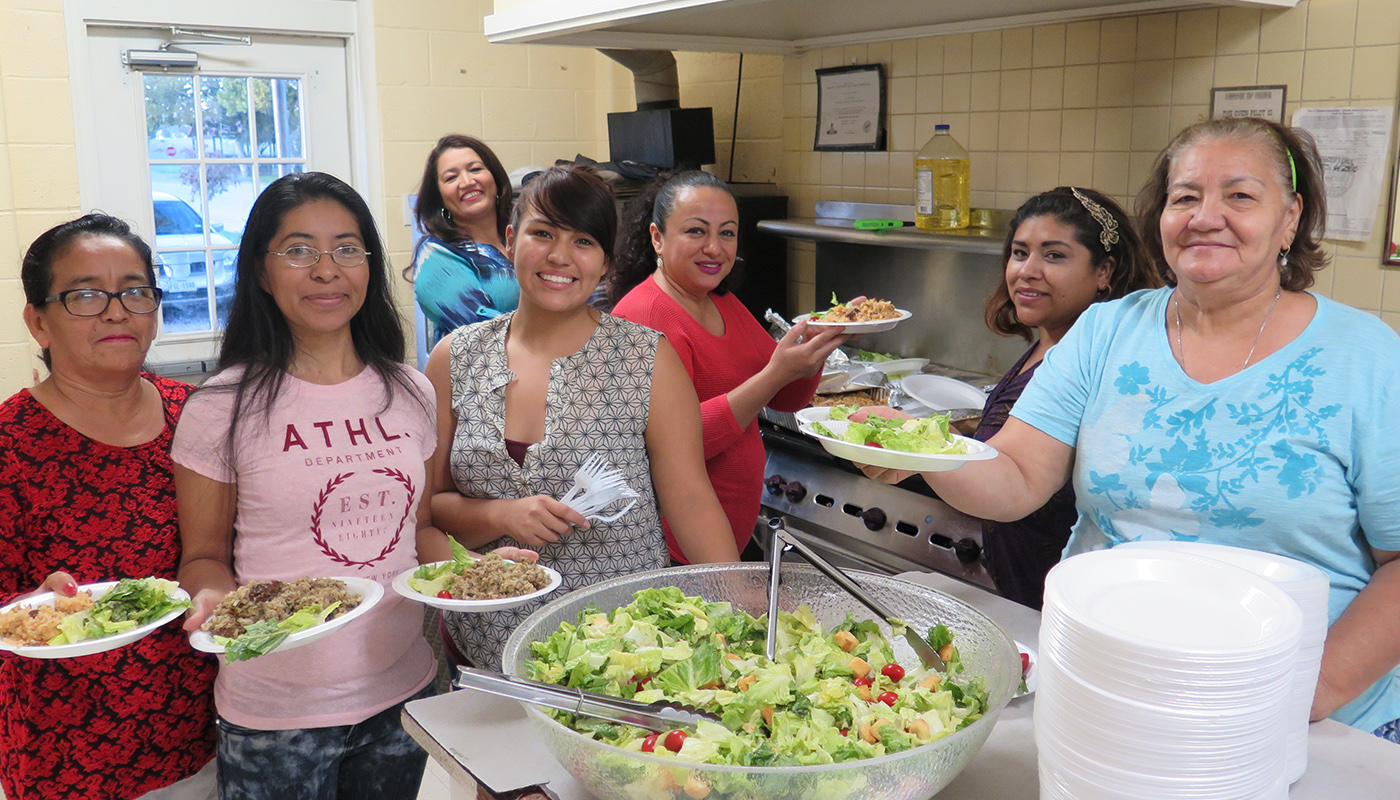
“If it weren’t for all the churches, we’d be right back where we were right after the storm.”
— Loa Heckendorn, Dickinson, Texas
On August 25, 2017, the most powerful storm to hit the state of Texas in more than 50 years pummeled the Greater Houston area. Hurricane Harvey. Tens of thousands of residents were devastated with major damage to property and homes.
During major disasters like Harvey, Episcopal Relief & Development works closely with church partners to address immediate and long-term needs in impacted communities. Prior to this event, the organization’s US Disaster team provided disaster preparedness training and resources for volunteer leaders in most dioceses around the Episcopal Church including the dioceses of Texas and West Texas. Immediately after the hurricane, key stakeholders across impacted areas were invited to participate in informational webinars to help even more local partners respond. Church leaders were mobilized to distribute resources for temporary housing and household goods, using church knowledge to prioritize those with the greatest need.
Native Texan and Major Gift Officer for Episcopal Relief & Development, Mike Smith, recently traveled to his home state to witness and document the devastating impact of the storm. During his trip, he gained a deeper awareness of how neighbors work together during recovery efforts. Mike also witnessed the strength and power of ecumenical cooperation as congregations and church partners leveraged local relationships to meet the immediate and complex needs of diverse communities throughout Texas.
Read the following short stories that Mike captured during this visit.
Love Made Manifest:
A House in Pearland and a Street in Conroe
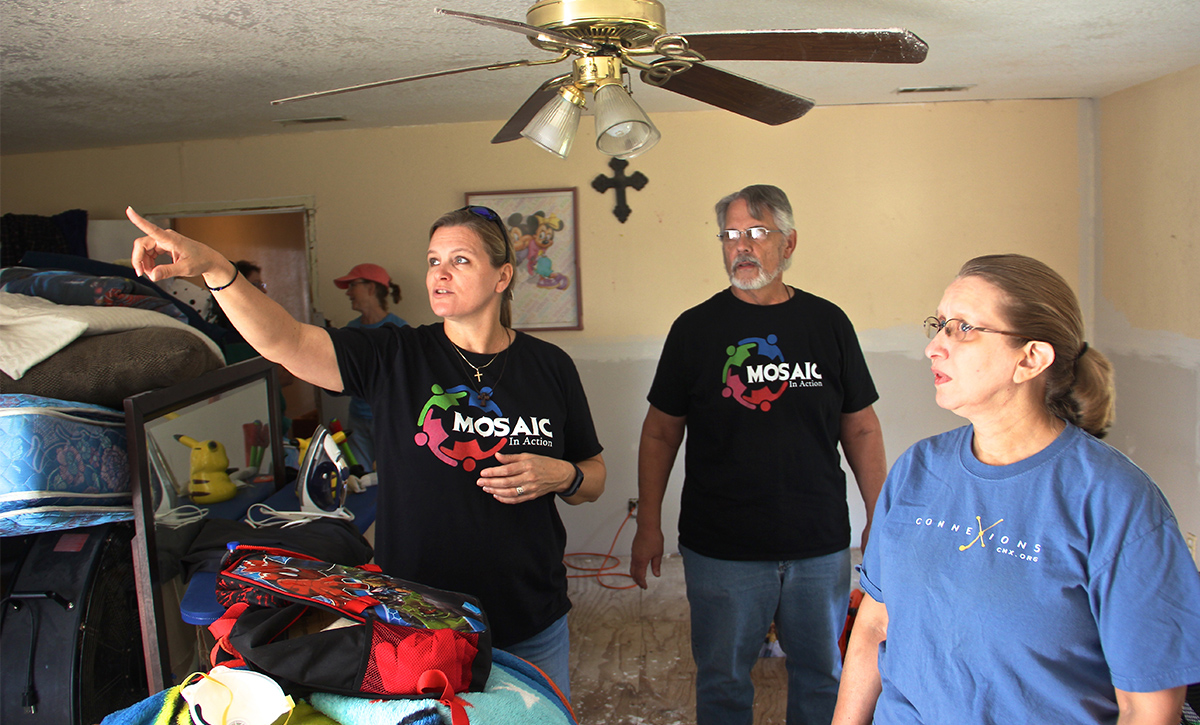
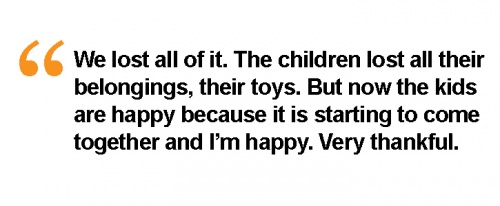
Episcopal Churches and Episcopal Relief & Development partners are doing amazing work all over the vast greater Houston area. Literally, hundreds of church communities are working every day to serve those in need.
St. Andrews Church in Pearland, Texas, 23 miles south of Houston, developed such an appetite for service that three years ago its members formed an outreach mission church called MOSAIC. They hold events with names like “Messy Church,” “Yoga Worship” and “Dinner Worship.” And they rebuild houses for those who barely made it through Harvey. Debbie Allensworth is MOSAIC’s director. She assembles volunteers, organizes their schedules, helps procure building materials and tries to keep everything on schedule.
I visited one of MOSAIC’s rebuilding efforts in Pearland, just a few miles from St. Andrews. It is the home of Norma Gallegos, a single mother of four who supports her family on her job at a local fast food restaurant. Her house lost its roof, floors, several feet of walls, and her family lost many possessions. Norma and her children, ages 8 to 17, have continued to live in the house through rebuilding. It’s chaotic and difficult, but the work is getting done.
“I worked very hard to provide the necessities of life,” Norma said. “We lost all of it. The children lost all the belongings, their toys. They were very sad. But now the kids are happy because it is starting to come together and I’m happy. Very thankful.”
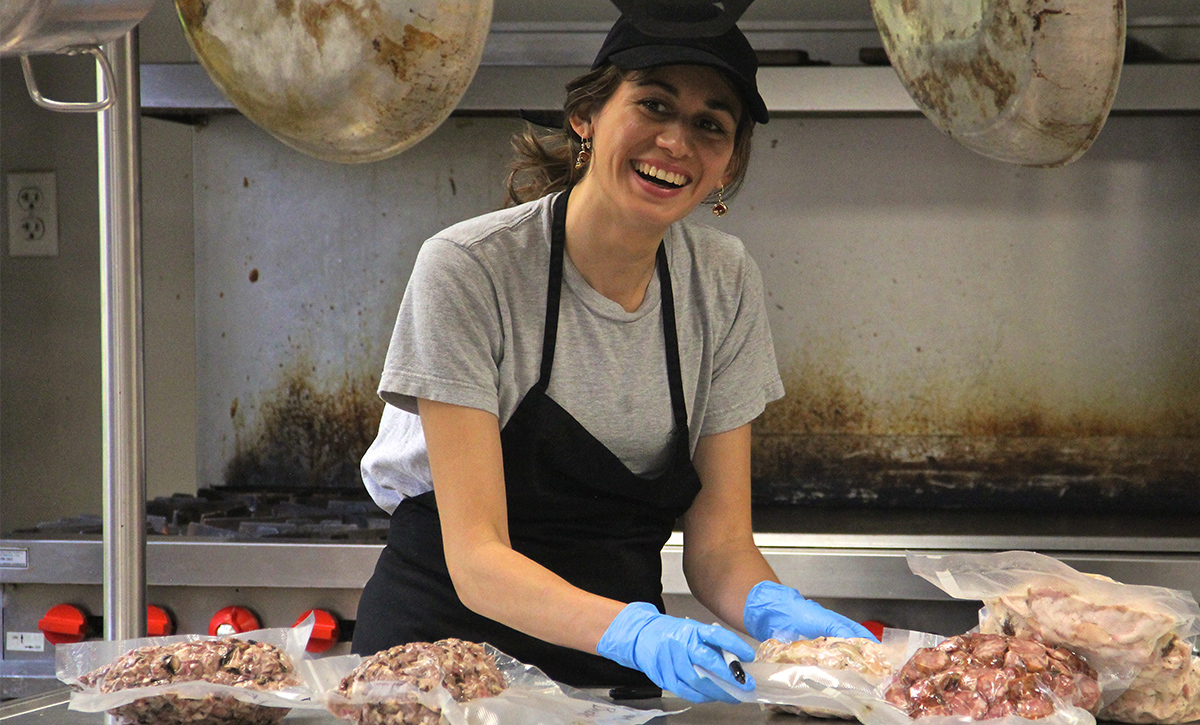

40 miles north of Houston in Conroe, Texas, The Abundant Harvest Food Truck serves meals to residents of the Needham Road community. On this half mile long street, River Oaks Drive, with about 100 homes, everyone lost a lot and some everything.
Molly Carr is the human food service machine that makes this ministry without walls work. I met her at the kitchen of Trinity Episcopal Church in The Woodlands, Texas where Molly, Dulce Salas and their volunteers prep and cook meals.
They had received 160 pounds of donated Texas barbeque—brisket, sausage, ham and chicken that morning. It would make 400 meals. Molly, Dulce and volunteer Michele Berkowitz made short work of prepping the food, Michele said she saw the food truck on the street one day, looked it up and liked what she read. This is the fourth time she has volunteered to help. The women sliced, pulled, chopped and vacuum-sealed the food and stashed it in the freezer.
Molly drove me to the Needham Road community where she serves regular meals with the help of neighborhood women. Nestled between the West Fork of the San Jacinto River and Grants Lake, the street got hammered with floodwater from both sides.
Most of the residents in this community work long days and try to repair their homes between shifts. Some of them are lucky enough to have a trailer, but some are living in tents in the yard. It’s a close-knit community and people look after one another.
After preparing the meals for the food truck, Molly, Dulce and the volunteers meet at one of the residents’ houses and eat together and often have church together.
Molly said she couldn’t think too long about how much work there is still to do, how many people are in need all across the Houston area. “I can’t think about the world’s problems. I just try to stay focused on this little piece that I can do something about” she said.
An Organizer Who Connects People with Services
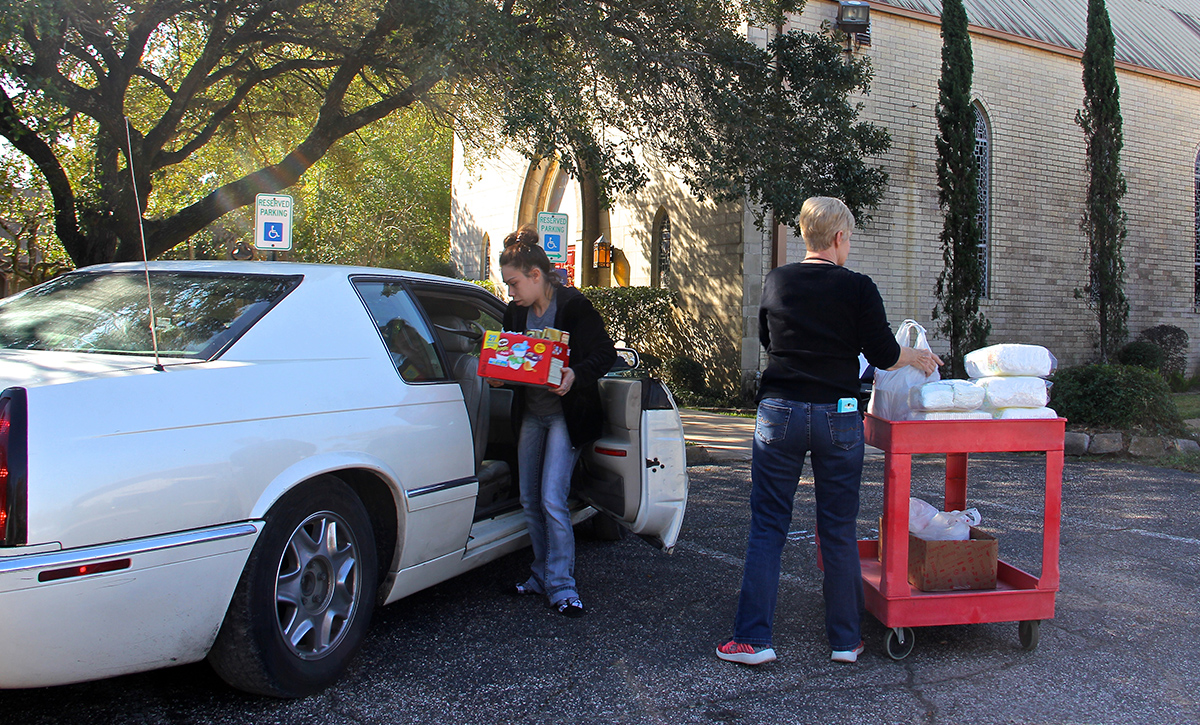
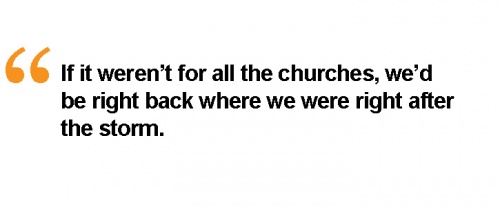
116 days after one of the worst storms ever to hit Houston and South Texas, reminders of Hurricane Harvey are everywhere: from spray-painted scrawls that designate “condemned” buildings to piles of wallboard, carpet and two-by-fours mucked out of homes that can still be salvaged.
There is also a lot that isn’t so obvious, such as the work being done by churches and their indefatigable volunteers from the very communities that were hit or neighboring areas.
Loa Heckendorn is food pantry supervisor for M.I. Lewis Social Services in Dickinson, Texas.
“If it weren’t for all the churches,” she said, “we’d be right back where we were right after the storm.”
On the day I arrived, Ms. Heckendorn was handing diapers, boxes of cereal, and other supplies to Chelsea Weaver, whose baby Ava was born five days before Harvey hit. The family needed food, but the M.I. Lewis offices and warehouse couldn’t supply it on their own. Inundated during the storm, their food supply had been ruined.
Enter Holy Trinity Episcopal Church, which donated space to start a new pantry as well as space in the church buildings for the agency’s office functions.
“Holy Trinity has accommodated anything we need,” said Loa. “A lot of the food has come from the church. I’m not even worried about restocking our pantry. The churches will do that.”
Kecia Mallette is director of operations for Holy Trinity Episcopal Church in Dickinson, Texas. She juggles two cell phones and scores of relationships she has made with people all over Dickinson, where roughly 80% of residents suffered damage from Harvey. She bounces over the roads in her black Nissan Frontier, checking on the progress of a rebuilding project or meeting with clergy from other churches in the community, or just stopping by to check on people.
Originally, Mallette’s job was part-time. She came in to help with the parish business processes and to hire and train a new office manager. But Harvey changed all that. Mallette became a founding member of the Galveston County Long Term Recovery Group, sanctioned by FEMA (the Federal Emergency Management Agency). She’s supervised the building of a new website for a group called Galveston County Recovers.
“It’s an interfaith group that includes non-profits, faith-based organizations, community groups, all of them local,” she said. “The disaster was so broad-based, it required all these groups working together.”
Kecia said that approximately 45,000 people applied for FEMA benefits in Galveston County, south of Houston, and probably 4,500 of them will need individual case management to guide them through the maze of agencies they must navigate to get back on their feet. If Kecia thinks this is an overwhelming job, it doesn’t show. She seems to take one thing at a time, and then move on to the next.
And she has helped put Holy Trinity at the forefront of disaster response in the community.
A Melting Pot of Cultures Gather For A Food Fair
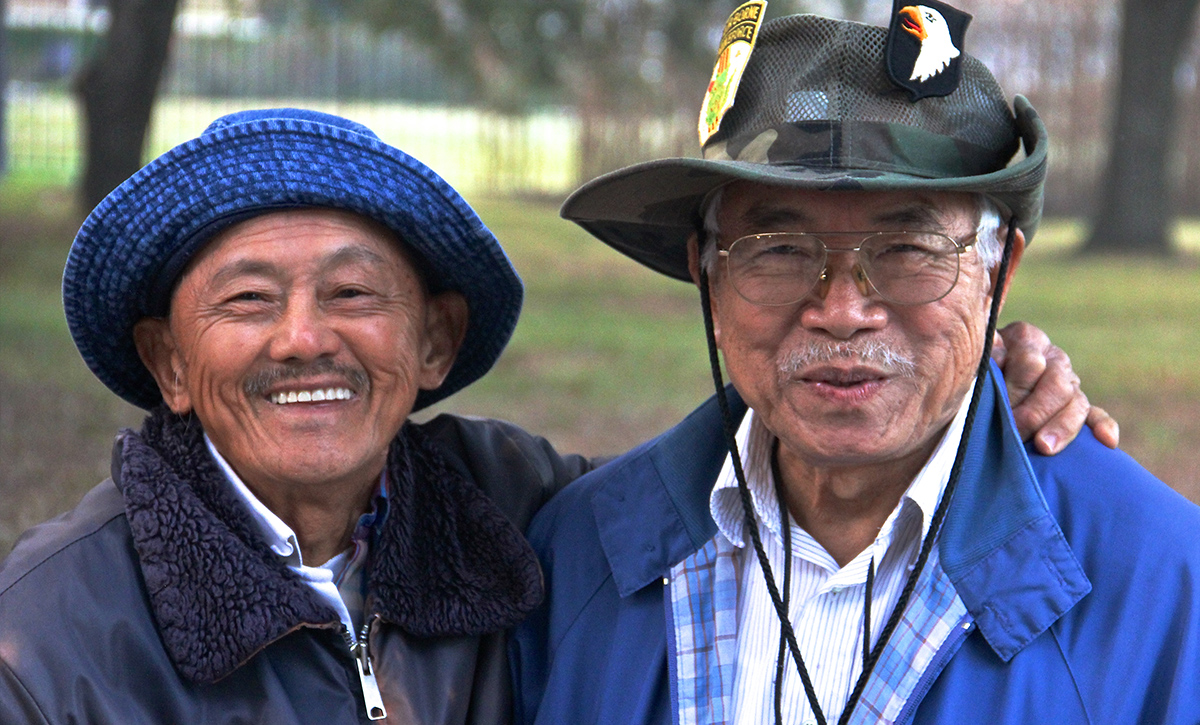
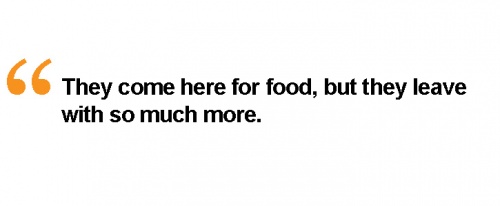
The line forms before sunrise on the day of the “Food Fair” at ECHOS, Episcopal Community Health Outreach Services. Snippets of Spanish, Vietnamese and Mandarin, as well as English, are heard as people huddle under blankets in the parking lot of The Episcopal Church of the Epiphany. Executive Director Cathy Moore buzzes around the office, making sure that the doors can be opened soon to the 150 or so who wait patiently in the morning cold. A table with donated clothing, diapers, bedding and toys is available to all.
Each client fills out paperwork and interviews with an ECHOS case manager to determine the family’s needs. The staff at ECHOS helps clients sign up for the Children’s Health Insurance Program (CHIP), Medicare and Medicaid. Health care teams from University of Texas Dental Branch, University of Houston Optometric School and Texas Children’s Hospital provide services on a regular basis.

“They come here for food, but they leave with so much more,” Moore said.
“We want to help them get health services before they walk into an ER when things are so bad, their foot has to come off,” she said. “People wait so long because they think they can’t afford care.”
Through November ECHOS had served almost 11,373 individuals and more than 5,000 households this year. After Harvey, 49% are new clients.
ECHOS was established by The Episcopal Church of the Epiphany in 2001, a response to the rapid influx of immigrants and changing demographics in the Southwest Houston community. Many of ECHOS clients live nearby in apartments, many of which were severely damaged by the flooding.
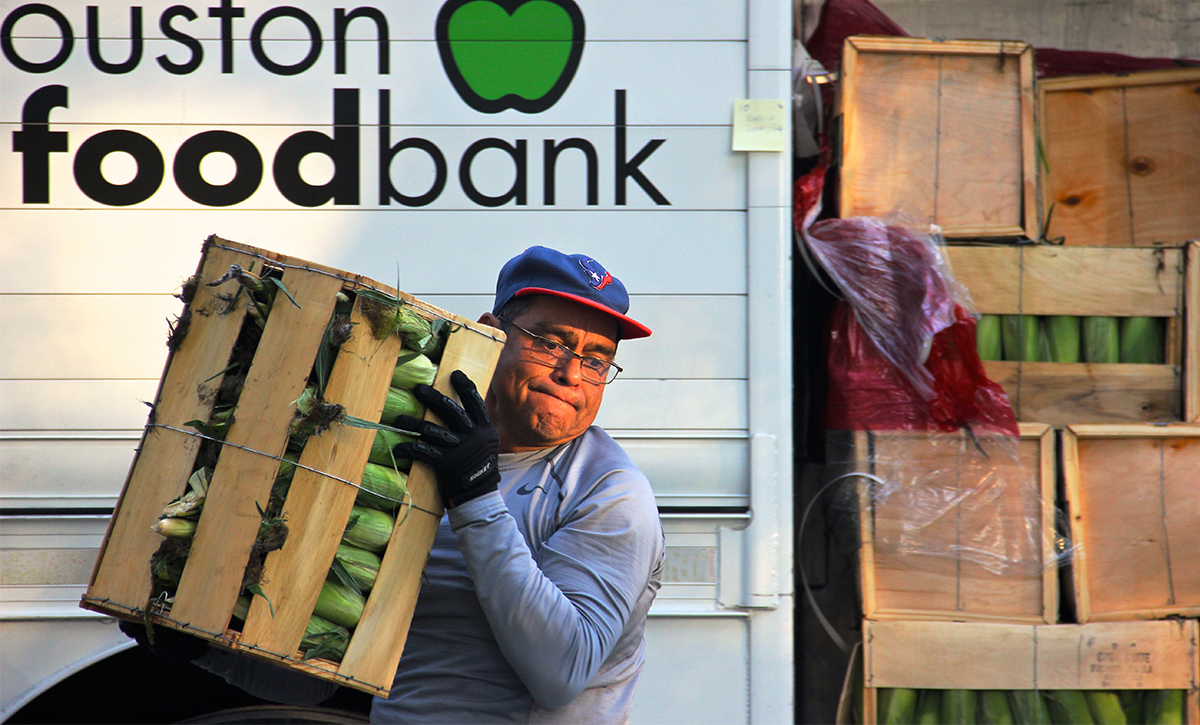
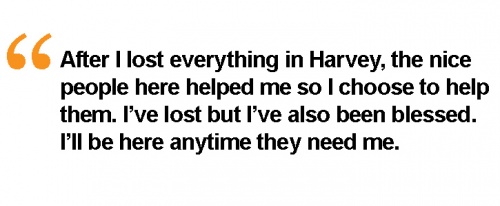
ECHOS provided rental assistance to many who lost their apartments and needed help getting into new housing. They have also provided beds, dressers and tables.
The twice-a-month food fair provides each family 45-60 pounds of fresh produce, fruits, bread and dairy products. The Houston Food Bank is ECHOS’ long-time partner.
Louis Ramirez hoisted boxes of corn from the food bank trailer. He lives in the Southwest Houston neighborhood and was hit hard by the storm. Ramirez finally got back into an apartment on Nov. 1, with rent assistance from ECHOS.
Now he is the one helping others as a regular volunteer at ECHOS.
“After I lost everything in Harvey, the nice people here helped me so I choose to help them. I’ve lost but I’ve also been blessed,” he said. “I’ll be here anytime they need me.“
A Home Restored
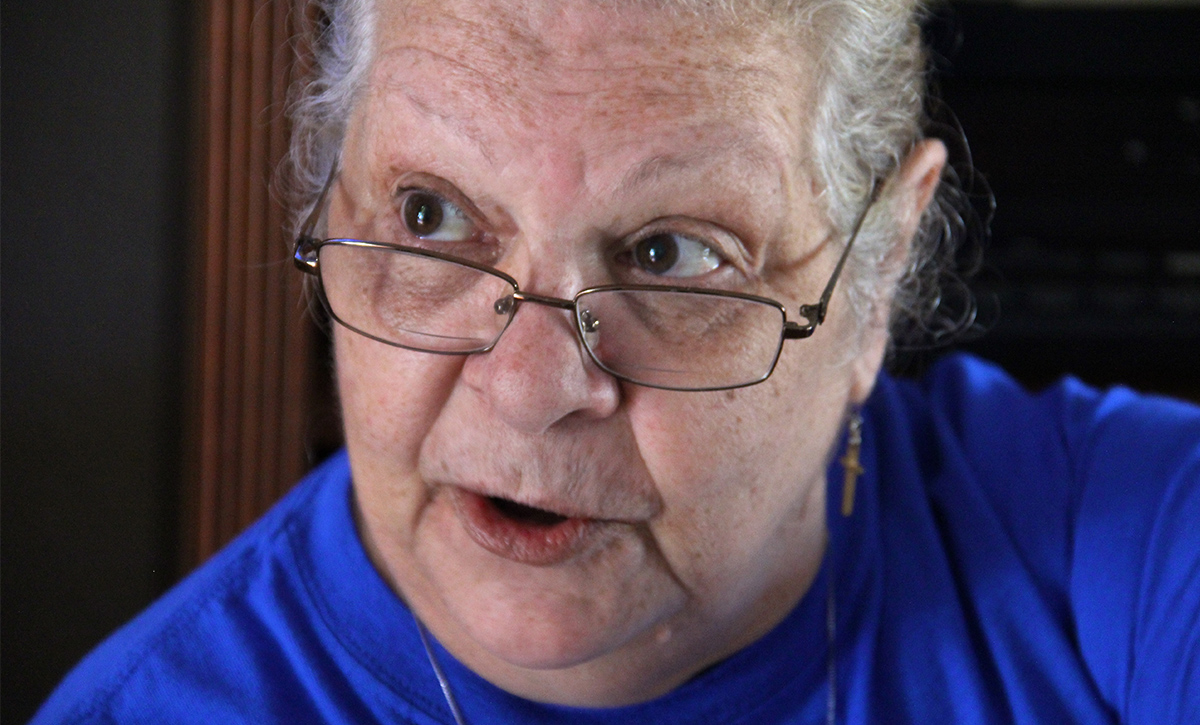

Kathy and John Bradley stayed in their Dickinson home during the storm. John has emphysema and a heart condition. Kathy had knee replacement surgery recently, so they both had trouble getting around. When it became obvious that they needed to get out of their house, it was too late.
The mandatory evacuation order came late at night when most people, including the Bradleys, were asleep. The couple couldn’t see how to leave safely or where they would go. They played cards at their kitchen table as the waters rose.
“When the water started coming in,” Kathy said, “we swept it out. I’ve lived in Florida so I’ve dealt with hurricanes before. “
The “22-foot ditch” next door—the bayou—was supposed to handle the excess water. It didn’t. And like so many of their neighbors, the Bradleys’ walls were damaged. When the water finally receded, the house was a mess. It needed extensive repairs.
An insurance adjustor walking down the street of abandoned houses saw a debris pile in the front of the Bradleys’ house. It was the only indication that someone might be living there, so he knocked on the door. The adjustor called a local Presbyterian church that put the Bradleys in touch with The Fuller Center for Housing. Fuller is a non-profit ecumenical organization that partners with community groups to build and rehabilitate homes for people in need.
Fuller sent in a team to rebuild; when I visited, they were putting the finishing touches on the house, which now has a new roof, back wall, siding, bathroom, drywall, kitchen island and cabinets. Kathy chose the colors. Everything except the brick was rebuilt.
Fuller decides whose house can be rebuilt based on several priorities, including: people without insurance, income at 50% of area median, elderly, handicapped, single parents with children at home, and owned by the residents. Homeowners are only required to pay what they receive from their insurance company or FEMA. The estimated cost of the repairs done to the Bradleys’ home was $75-80,000, according to Brian Gioe, Fuller’s building director.
The Bradleys have lived in their house at 4805 27th Street East for 30 years. He’s a former Navy veteran who served on the USS Saratoga. She spends a lot of her time taking care of him.
“I pinch myself all the time about this house. I would never have believed this could happen. If this is our last Christmas together, it will be in a beautiful house.”
Forged in a Flood, Two Churches Form a Unique Partnership
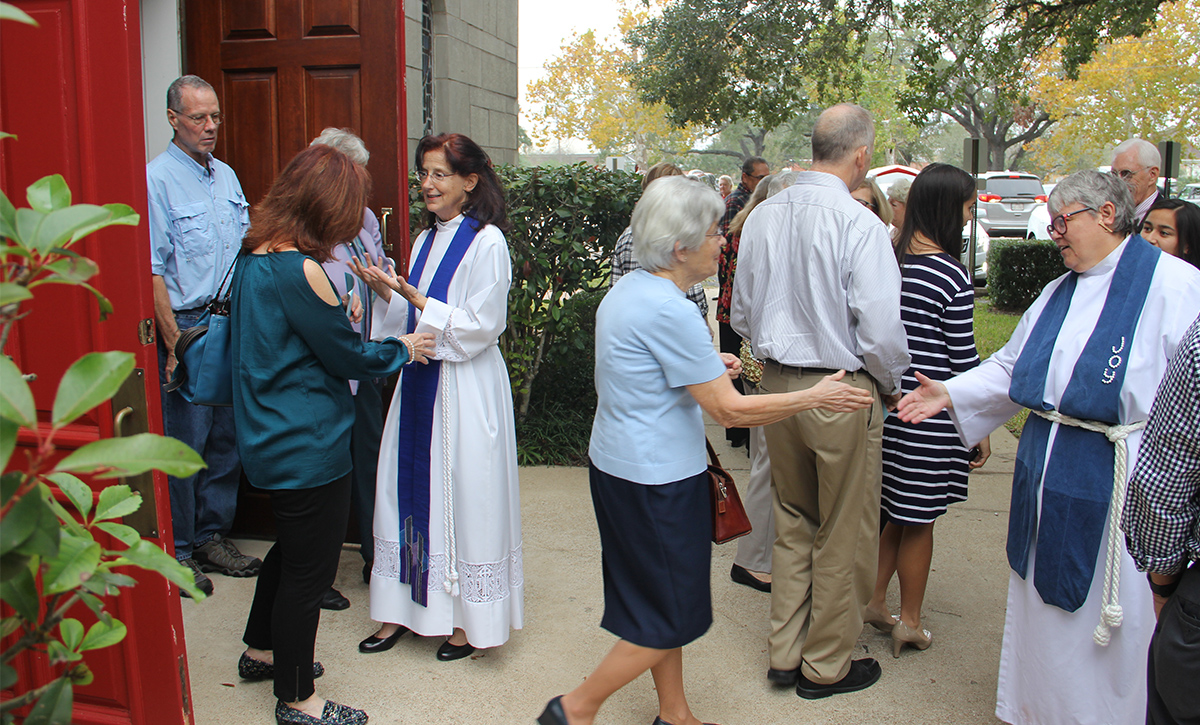

When Hurricane Harvey and its endless rains pummeled South Texas, Holy Trinity Church in Dickinson, Texas somehow remained above water, miraculous given that the church building sits next to the banks of the Dickinson Bayou.
Faith Lutheran Church, 1.6 miles around the corner and down the street, wasn’t so lucky. Faith lost pews, hymnals, carpet, flooring and walls. Parishioners don’t expect even to get back into the building until late January. The main worship space will take longer and will cost more than they have.
The Reverend Stacy Stringer, rector of Holy Trinity Church, reached out to her counterpart, Pastor Deb Grant, inviting her and the Faith congregation to share Holy Trinity’s space and worship together. They’ve been doing so ever since, with a kind of tag team approach, alternating preaching and celebrating.
I was there on Advent 1. The priests’ stoles and the Advent wreath candles were blue, not purple, a simple act to recognize the Lutheran tradition.
In the Litany for Advent Hope, Pastor Grant prayed: “People of God, what will you do with hope?
The congregational response: “We will light a candle. We will not let despair rule the day.”
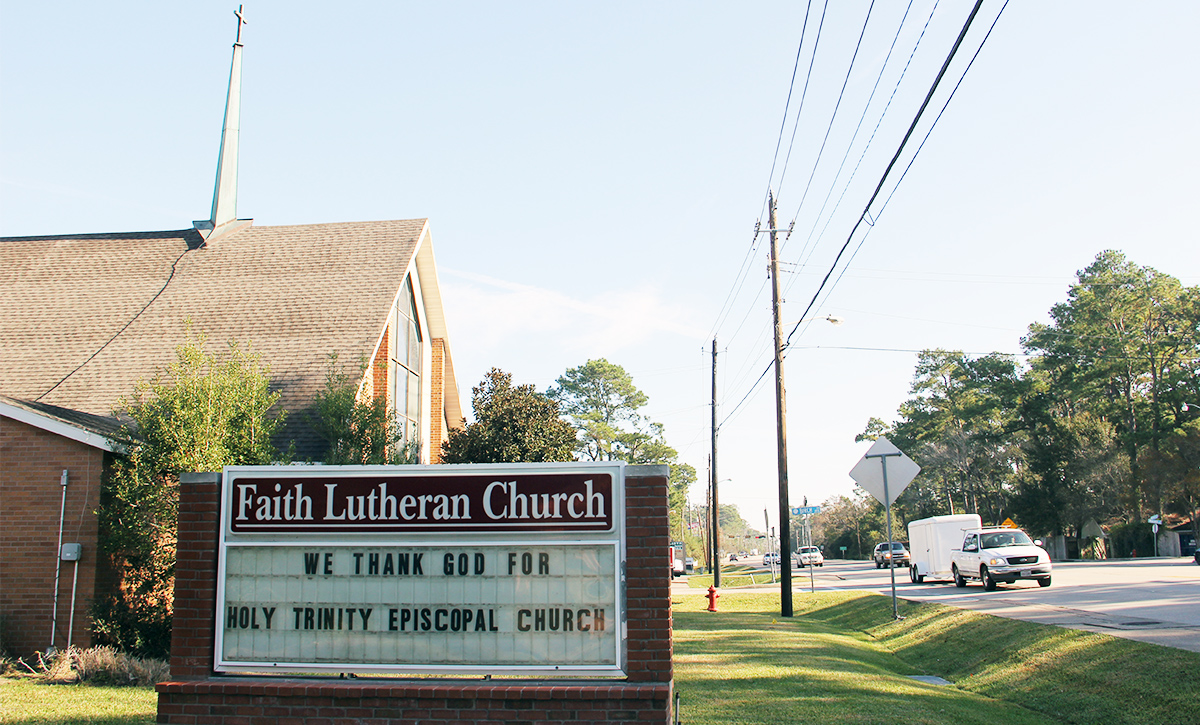

In her sermon, Reverend Stringer spoke of the darkness that had threatened so much of the Dickinson community since Harvey, and how easy it can be to fall into despair. But she reminded worshipers that their community had not fallen, that they were bringing light to the world through their care for each other.
“Advent tells us to keep watch, prepare, to see what is needed and then do something to help, “ she said.
Reverend Stringer never thought much about disaster relief and response, but now says, “Maybe this is exactly what I’m being called to do.”
The church parking lot, which was used as a launching point in September for a flotilla of rescue boats, was full on the Sunday I visited. After services, Rev. Stringer and Pastor Grant greeted worshipers after the 10:30 service.
People lingered, talking with the ministers and each other, finally leaving to return to their lives, some of which will be in flux for a long time.
Heading back down route 517, I passed Faith Lutheran church and saw the marquee that said, simply: “We Thank God for Holy Trinity Episcopal Church.”
Relearning the Meaning of Ministry
at Mount Olive Baptist Church
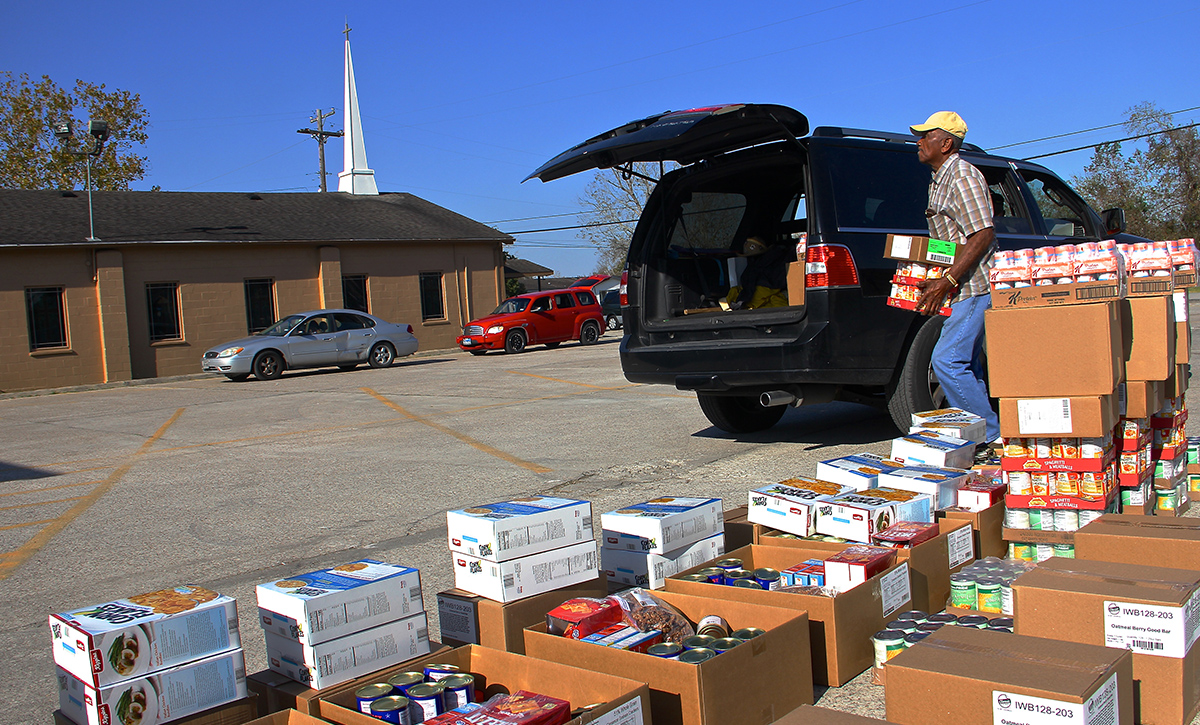
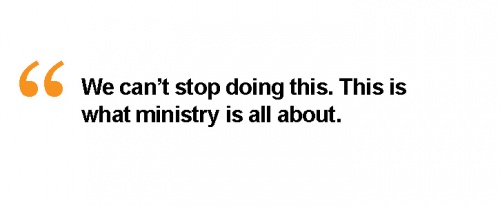
It started with a drive through the neighborhood. Pastor Amos Charles Sowell, the minister at Mount Olive Baptist Church in Dickinson, saw peoples’ houses flooded out, all their possessions ruined.
“I didn’t suffer any damage,” he said. “I saw all these other people who lost their homes, cars, everything.”
He decided, he said, that he didn’t need to play as much golf. He asked for volunteers to prepare meals in the church kitchen for neighbors who didn’t know where their next meal would come from. They started small, rice and beans mostly.
“People came here devastated, with tears in their eyes,” he said.
A food pantry contacted the church and asked if it could deliver two truckloads of food. Pastor Sowell said they would take it. Since then the church kitchen has received more than 45 truckloads, and cars line up around the corner and down the street to pick up food.
Pastor Sowell said they give a lot of food to people who come back two or three times a day. But he knows it’s because they are feeding other families, relatives and neighbors. There is a substantial undocumented population in the area, and they are likely some of the recipients.
Mount Olive has 150 active members and twenty of them volunteer regularly to sort, organize and pack. When we visited, two women packed boxes and two men moved them into trunks of waiting cars. Pastor Sowell says he packs boxes in his sleep.
He asked his congregation if they would like to stop this work at the end of October or November. The congregation decided to continue indefinitely. An older woman in the church who regularly volunteers told him, “We can’t stop doing this. This is what ministry is all about.”
The Faces of Harvey Recovery
(photos taken by Mike Smith with captions)

Mike Smith is a Major Gift Officer at Episcopal Relief & Development
Images: Feature Image—St. Paul’s Community Dinner, photo by Denise Trevino-Gomez; All other images taken by Mike Smith during his recent visit to impacted areas in Greater Houston.


